NOTE: THIS PAGE HAS A LOT OF GRAPHICS.
PLEASE BE PATIENT AS THE PAGE LOADS.
updated 3/21/2000
THE AIRPLANE AND AIRLINES PAGE
.....(continued)...
Boeing 767
The Boeing 767 was developed primarily as a competitor to the Airbus A-300,
both of which are comparable in size. The 767 has far surpassed, however, the
A-300 in terms of worldwide sales and popularity (and no wonder: its a
Boeing!). The 767 is offered in three different models: the 767-200, the
larger 767-300, and the recently-introduced-even-larger 767-400.
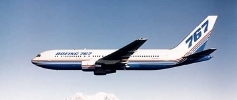
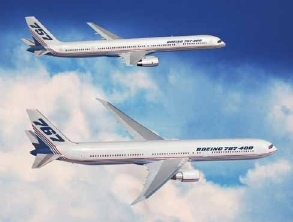
767-200 on its maiden flight.
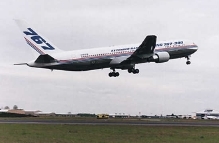
Big brother, little sister: the new 757-300 (top), and
the even newer 767-400 (bottom), taking a walk
through the clouds together. The 767-400 is the newest
of the 767 line, being the largest and most powerful.
767-300 launches away from the runway
at Paine Field on her first flight (above).
The model 767 was intended intially to be a replacement for the 707. Economy was in mind when the airplane
was being designed: two engines, a two pilot flight deck, large cargo capacity, large passenger capacity. Once
again, though, Boeing's design team went far beyond their inital targets for the new airplane in that it can do
so much more than what was originally intended. Boeing 767s are the most utilized twin engined aircraft
to cross the Atlantic and probably will be so for some time to come. So many 767s are flown on long distance
routes across the Atlantic that it has been dubbed "The Queen of the Transatlantic Twins."
Boeing 777
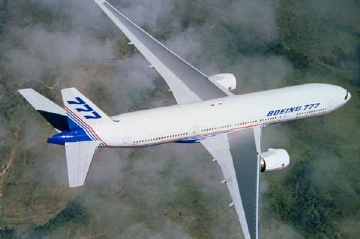
It's engines are huge. That's the first thing
you will hear about the 777 from anyone
who is even remotely familiar with Boeing's
new 777 jetliner. And its true: the intakes
of the engines powereing the 777 are almost
larger than the fuselage diameter of the
737. Three new jet engines were developed
for this airplane: The GE90, the Rolls-
Royce Trent, and the Pratt and Whitney
PW9000 series. All have intakes over 110
inches in diameter, making it the largest
jet engine ever produced.
Beyond that, however, Boeing truly broke
new ground when developing this airplane.
Although it may look a lot like the 767 (see above), it most certainly is NOT. The 777 utilizes the most advanced
airfoil technology - and beyond - available today. The flight deck is so advanced that new pilots have to be put
through a computer course before they even see a simulator.
The 777 comes in two versions: the 777-200 (pictured above), and the stretched (STRETCHED?!?) 777-300,
which is the "longest airplane in the world".
The tagline for the 777 is "Working Together". This particularly applies here as Boeing let the customers
design the airplane. The design and engineering team assembled respresentatives from airlines around
the world and asked them, "Okay, what kind of airplane do you want?", and the airline representatives told
them. The Boeing Company is very proud of their new 777, and well they should be: this airplane cost Boeing
over $3 billion to develop, and out of the factory doors in Seattle comes another Boeing winner.
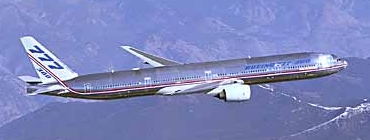
The Boeing 777-300, the
"Longest Airplane in the World",
on her maiden flight.
Convair 880 and Convair 990 "Coronado"
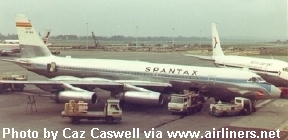
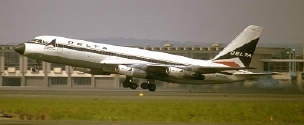
The Convair 880 (above left, in Delta Air Lines colors), and the Convair 990A "Coronado", above right, in the
colors of Spanish charter carrier Spantax), proved to be a commercial disaster for Convair. Both airplanes
were developed as a response to the Boeing 707 and the Douglas DC-8 jetliners, but neither were very success-
ful. Although the 880 and 990A were fast aircraft, and pilots loved them, they were difficult to operate profit-
ably and were subject to long and costly maintenance intervals.
- Boeing, the Boeing logo, and all associated aircraft designs and designations are registered trademarks
of The Boeing Company, Seattle, WA, USA.
- Convair and all associated aircraft designs and designations are registered trademarks of The General
Dynamics Corp., San Diego, CA, USA.